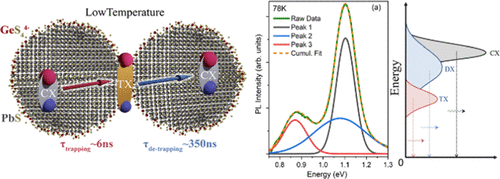当前位置:
X-MOL 学术
›
J. Phys. Chem. C
›
论文详情
Our official English website, www.x-mol.net, welcomes your
feedback! (Note: you will need to create a separate account there.)
Exciton–Ligand Interactions in PbS Quantum Dots Capped with Metal Chalcogenides
The Journal of Physical Chemistry C ( IF 3.3 ) Pub Date : 2020-12-02 , DOI: 10.1021/acs.jpcc.0c09790 Paris Papagiorgis 1 , Demetra Tsokkou 2, 3 , Kushagra Gahlot 4 , Loredana Protesescu 4, 5 , Andreas Manoli 1 , Felix Hermerschmidt 6, 7 , Constantinos Christodoulou 6 , Stelios A. Choulis 6 , Maksym V. Kovalenko 5, 8 , Andreas Othonos 2 , Grigorios Itskos 1
The Journal of Physical Chemistry C ( IF 3.3 ) Pub Date : 2020-12-02 , DOI: 10.1021/acs.jpcc.0c09790 Paris Papagiorgis 1 , Demetra Tsokkou 2, 3 , Kushagra Gahlot 4 , Loredana Protesescu 4, 5 , Andreas Manoli 1 , Felix Hermerschmidt 6, 7 , Constantinos Christodoulou 6 , Stelios A. Choulis 6 , Maksym V. Kovalenko 5, 8 , Andreas Othonos 2 , Grigorios Itskos 1
Affiliation

|
Colloidal quantum dots (CQDs) are typically decorated with organic molecules that provide surface passivation and colloidal solubility. An alternate but less studied surface functionalization approach via inorganic complexes can produce stable CQDs with attractive transport and optical properties. Further development of such all-inorganic CQD solids is dependent on the deeper understanding of the energetic and dynamic interactions of the new ligands with the CQD excitons. Herein, a series of four metal chalcogenide (MCC) ligands of the KzXS4 type were attached to PbS CQDs. Out of the four MCC complexes studied, we find that only K4GeS4 ligands yield robust PbS CQD films with bright photoluminescence (PL) in the solid state. A systematic spectroscopic investigation of the K4GeS4-capped CQD films provides evidence of the temperature-dependent ligand-mediated exciton delocalization and trapping processes. At low temperatures, efficient trapping at ligand-induced states is found to occur within ∼6 ns after photoexcitation, followed by a considerably slower exciton back transfer to the CQD core. At elevated temperatures, the CQD films become photoconductive, providing evidence of exciton dissociation via carrier transfer within adjacent dots. The addition of a thin CdS shell suppresses the delocalization and trapping of excitons, resulting in brighter emission and significantly slower transient absorption and PL dynamics.
中文翻译:

金属硫族化物覆盖的PbS量子点中的激子-配体相互作用。
胶体量子点(CQD)通常用提供表面钝化和胶体溶解性的有机分子修饰。通过无机配合物进行的另一种但研究较少的表面官能化方法可以产生具有吸引人的运输和光学性质的稳定CQD。这种全无机CQD固体的进一步发展取决于对新配体与CQD激子的能量和动态相互作用的更深入的了解。在本文中,一个系列四个金属硫族化(MCC)K个的配体Ž XS 4类型被装的PbS CQDs。在研究的四个MCC配合物中,我们发现只有K 4 GeS 4配体产生坚固的PbS CQD薄膜,固态时具有明亮的光致发光(PL)。对K 4 GeS 4封端的CQD薄膜的系统光谱研究提供了温度依赖性配体介导的激子离域和俘获过程的证据。在低温下,发现在光激发后约6 ns内会发生在配体诱导状态下的有效俘获,随后激子回传到CQD核的速度要慢得多。在升高的温度下,CQD薄膜变成光导性的,从而提供了通过激子解离激子的证据相邻点内的载流子转移。添加薄的CdS壳可抑制激子的离域和俘获,从而导致发射更亮,瞬态吸收和PL动力学显着降低。
更新日期:2020-12-17
中文翻译:

金属硫族化物覆盖的PbS量子点中的激子-配体相互作用。
胶体量子点(CQD)通常用提供表面钝化和胶体溶解性的有机分子修饰。通过无机配合物进行的另一种但研究较少的表面官能化方法可以产生具有吸引人的运输和光学性质的稳定CQD。这种全无机CQD固体的进一步发展取决于对新配体与CQD激子的能量和动态相互作用的更深入的了解。在本文中,一个系列四个金属硫族化(MCC)K个的配体Ž XS 4类型被装的PbS CQDs。在研究的四个MCC配合物中,我们发现只有K 4 GeS 4配体产生坚固的PbS CQD薄膜,固态时具有明亮的光致发光(PL)。对K 4 GeS 4封端的CQD薄膜的系统光谱研究提供了温度依赖性配体介导的激子离域和俘获过程的证据。在低温下,发现在光激发后约6 ns内会发生在配体诱导状态下的有效俘获,随后激子回传到CQD核的速度要慢得多。在升高的温度下,CQD薄膜变成光导性的,从而提供了通过激子解离激子的证据相邻点内的载流子转移。添加薄的CdS壳可抑制激子的离域和俘获,从而导致发射更亮,瞬态吸收和PL动力学显着降低。











































 京公网安备 11010802027423号
京公网安备 11010802027423号